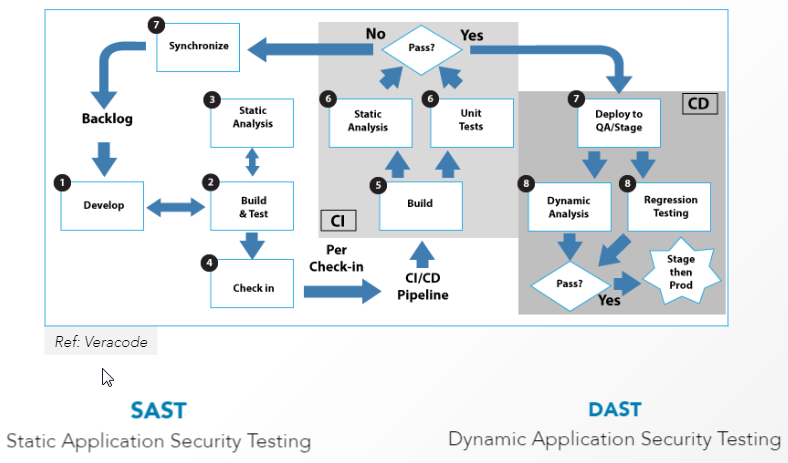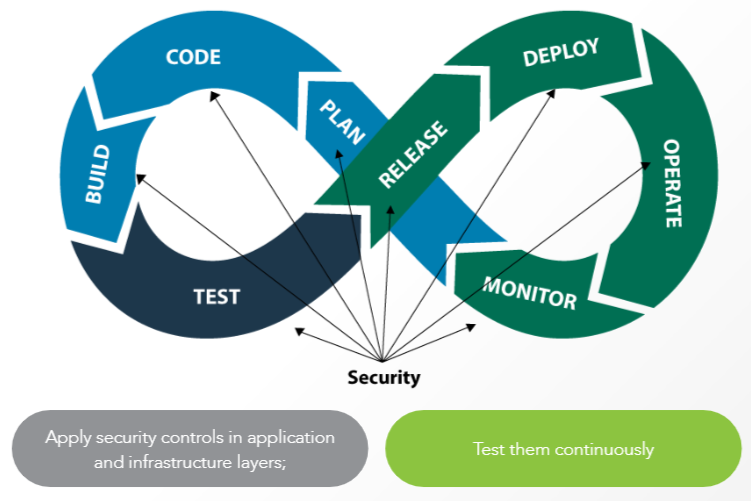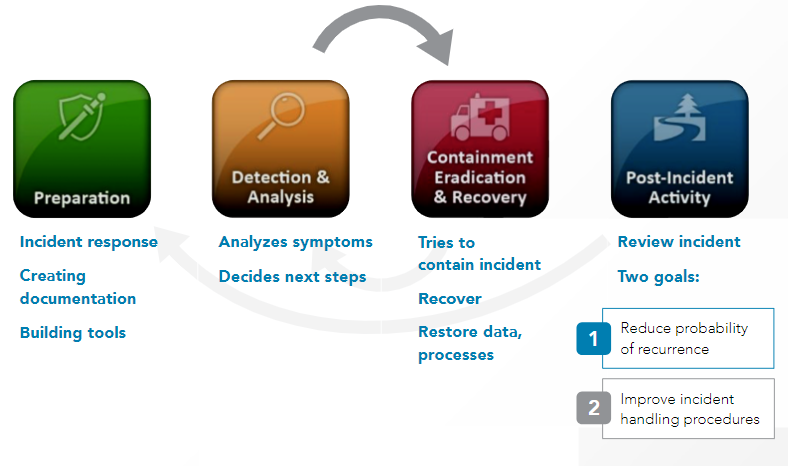History
Prior to 2010,
Continuous Integration and Continuous Delivery (CI/CD) relies on the automation of routine work.
Agile and DevOps
Basic SDLC has not changed .
Requirements ->Design->Development (Implementation)->Testing->Operations
Reference:

Tools and Framework:
Continuous Security:
Continuous Testing:
Security Architecture and Design Review
Security Code Review:
Security testing
Logging Pipeline includes:
Collect->Stream->Analyze->Store->Access
Incident Management:
NIST 800-61
For Detection & Analysis
For Containment Eradication & Recovery
For Post-Incident Activity:
KPI (Key Performance Indicators) based on business needs and compliance requirements
- Structured Development methodologies
- Clent-server
- Waterfall Model
- Moved from structured development methodologies to object-oriented paradigm
- Moved from client-server to service-oriented architecture
- Moved from the waterfall model to agile methods
Agile & DevOps
Continuous Integration and Continuous Delivery (CI/CD) relies on the automation of routine work.
Agile and DevOps
Basic SDLC has not changed .
Requirements ->Design->Development (Implementation)->Testing->Operations
Microsoft Security DLC
Reference:

How to Develop a Security Strategy within DevOps
Tools and Framework:
- Culture: Collaboration and Contribution. Everyone is responsible for security. Goal is equal to safely distributing security decisions
- Processes: Significant changes to existing workflows & processes. Team communication, collaboration, reporting, measurements, security, development, operations, end to end, implementing changes, continuous loop.
- Technologies: Threat modeling, attack surface evaluation, static & dynamic analysis, penetration testing, fuzz testing
Five Principles for Securing DevOps
- Automate Security in: automated invocation security testing with Comprehensive API.
- Integrate to Fail Quickly: Integrating security CI/CD pipeline for application security.
- No False Alarms
- Build Security Champions: train developers in security coding, a force multiplier, reduce culture conflict, embed app security knowledge into team
- Keep Operational Visibility: application security continues, closed loop feedback, security incidents
SAST vs DAST
SAST (Static Application Security Testing) and DAST (Dynamic Application Security Testing)Continuous Security:
- Test Driven Security (TDS)
- Write tests that represent desired behavior
- Test will fail and that is expected.
- Implement controls to pass TDS tests
- Security teams help developers and IT operation teams to implement controls
Security Architecture and Design Review
- Product Requirements
- Early Designs
- Add security based on threat models
- Architecture is reviewed
- Security controls proposed
Security Code Review:
- Review code
- Verify security controls
- Verify architecture requirements
Security testing
- Can the product withhold a simulated attack?
- Manual testing
- Automated tools
Monitoring and Key Performance Indicators
Logging Pipeline includes:
Collect->Stream->Analyze->Store->Access
Incident Management:
NIST 800-61
For Detection & Analysis
- Blended approach to detection
- Business-focused Metrics
- Data-driven investigations
For Containment Eradication & Recovery
- Actionable alerts
- ChatOps for Communication
- Runbooks for remediation
- Adopt infrastructure as Code (IaC)
For Post-Incident Activity:
- Keep post-mortems actionable
- Analysis phase is worthless if little or no action is taken
- Lessons learned must be reflected in incident management runbook
KPI (Key Performance Indicators) based on business needs and compliance requirements
- Availability
- Change Failure
- Change Lead Time
- Change Volume
- Customer Issue Resolution Time
- Customer issue volume
- Defected Burn Rate
- Deployment Frequency
- Logging Availability
- Mean Time Between Failures (MTBF)
- Mean Time to Failure (MTTF)
- Mean Time to Recovery (MTTR)
- Number of False Positives
- Number of False Positive
- Number of Functional/Acceptance Tests
- Number of Passed /Failed Security Tests
- Number of unit/integration Tests
- Security Benchmark Deviation
- Security Controls
- Test Coverage
- Time to Patch
- Time to Value
- Vulnerability Patching Frequency
- Vulnerability Patching Lead Time












No comments:
Post a Comment